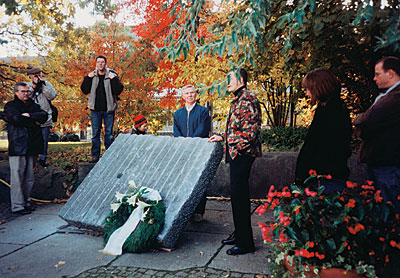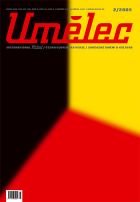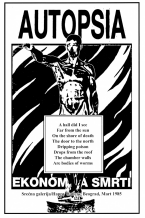| Umělec magazine 2005/2 >> Thorsten Schlopsnies | List of all editions. | ||||||||||||
|
|||||||||||||
Thorsten SchlopsniesUmělec magazine 2005/201.02.2005 Halka Třešňáková a Ivan Mečl | revolutionary DIY | en cs de |
|||||||||||||
|
In 2000 Thorsten Schlopsnies—aka Todosch—attempted to attack the ongoing Hannover Expo with a paramilitary convoy. He intended to raze it all to the ground, but the police stopped him. A few years later, he had dog teeth implanted into his jaw, and he established the myth of a Dog Tunnel (Hundetunnel) in Chicago—an event that has yet to be sufficiently documented. Even though the details have become so veiled, its legend has been spread by word-of-mouth. The myth emerged during the documenting of the Chicago underground and its inhabitant, Todosch, when an unknown tunnel was discovered. Todosch, the harbinger of this discovery, was dressed in yellow overalls with a rugby helmet; with a wildly painted face, he constantly flashed his canines. A film producer refused to release hours of film footage intended for a documentary, and it is all locked up somewhere in an archive. All that remains is a short silent film with an authenticity akin to Blair Witch. It was a very risky enterprise that came to a close when a techno-satanist church got hot on Todosch’s track, and he fled from the American scene. The last straw was a large work of graffiti painted in blood.
Today the Hannover Expo 2000 lies in ruins. It collapsed into itself, abandoned by its creators and visitors, and the Lithuanian pavilion has been squatted by artists from Todosch’s circle. The idea of an individual is stronger than the collective self-presentation of civilization. It would suffice to listen to the exceptional opinions, although they come from the margins, and we could often avoid the disasters of mainstream culture. We would learn how to not abandon things and how to pay attention to the dismissed things. Maybe we then would stop producing things created to be abandoned in the future. When we consider the exceptional art personalities of Germany today, they are—despite all their international tendencies—deeply rooted in the German soil. When I first saw this sculptor’s public performances, he was on his knees on the Auguststrasse in Berlin, first pulling up cobblestones, and then clawing with his bare hands through the hard surface to softer earth, deeper and deeper until he disappeared from view. This was one of Todosch’s actions associated with the Hundetunnel Project. Typically, Todosch incessantly gathers and collects various objects and materials that he needs for his subjects. As he says himself, he is most interested in stories—absurd tales of people, of houses or of a lost bag. He works on his projects with the seriousness and gravity of a scientist. He has established institutions of his own—The Institute for a Recycling Reality, Borderline Activities, Das Falten von Böhmen, and Conscious Force. To operate these absurd and non-existent institutions and offices, he distributes official-looking forms, questionnaires and other documents. He has a set of stamps and seals, and he maintains correspondence and archives, and he documents everything. In doing this, he creates the illusion of an ongoing bureaucratic dispute with genuine, and similarly absurd and bizarre German state institutions. As such, Todosch’s work cannot be investigated individually, out of the context of an extended length of time. He incessantly labors over the course of his entire life. He doesn’t finish them, they are still open to the fictitious life-long court cases going on in the subconscious schizophrenic split into the essential ego and the surrounding offices. These bureaus can issue permits even for the sunrise and sunset, or for the darkness at night. An irreal lawsuit in a self-serving spirit and purposeless bureaucracy enables the employment of all sorts of bureaucratic means, countless stamps, forms, applications and permits even for a personal view and realization by request. Some art works are already known to the public: a five-ton granite figure, a hole in the middle of the street, an octopus conglomerate of chopped up Christmas trees stuffed into a parked car, a rocket range on a street in Hannover, six wagons, and Todosch sleeping in the middle of the city traffic. These are just some significant moments of his long-time projects. He often works on them – except for the made-up institutions – with the assistance of performance, discussion and opinion polls. Todosch works in just about all artistic fields but not with galleries. “It is something other than reality to contact a gallery owner and take part in that artificial art situation,” he says. “One of my teachers always answered the question ‘Is it art? Is it not?’ with the answer: Kunst passiert! Art is happening! And that’s what I stick to.” The Revolutionary Handymen – The Danse Macabre of Things During the preparations for the Hannover Expo, Todosch had assembled all the material for the planned journey, with carts loaded for his convoy. The voyage had begun before the actual departure from the center of Berlin and had been projected to wind up at the opening of the Hannover Expo. He had calculated that according to the limited capacity of the individual carts—some lacked wheels with only a sled undercarriage—the tour was to take about six months. For two years, Todosh has been collecting old garbage and scrap from squats in Prenzlauerberg and Berlin Mitte. He would arrive, load a cart and bring the material to his workshop where he deposited it all: pieces of wood, old wardrobes, stoves, gas stoves, and other junk. He further sorted and combined what he had accumulated, and then loaded it all onto the undercarriages or skids of various sizes. What resulted was a trailer of six overloaded, handmade carriages, stuffed with useless and discarded objects—the detritus of everyday life. “Things keep gathering themselves, so that at the outset of the new millenium, they could come together as a platoon of a massive amount of useless objects, and one person drags it all towards Hannover by himself, on foot. As this is a counterpoint to all the new and newly produced objects exhibited for admiration and purchase.” Todosch set out on this long and physically demanding pilgrimage as a mere servant of the accumulated clutter. The load was very heavy, and occasionally he had to unhook a heavier cart and return for it later. He had to stop many times and blocked traffic, not for the purpose of performance humor in itself, but because he tried to proceed with a stubborn seriousness. He was all sweaty and everyone around was irritated because he had blocked their usual parking places. His slow passage around shops, hotels and restaurants wasn’t a good show. The only pleasant reaction came out of compassion. An old lady wanted to help him drag the wagon. A reception clerk from a hotel near where his wagons got stuck realized he could grumble all day, but would still have to help him in order to get rid of the cart. For two weeks he slept totally exhausted on the street in his sleeping bag, next to his wagons—until two weeks later when he was stopped by the police. Todosch is consistent in neither leaving nor creating any further art products. He merely directs the spectator to see his point of view; from there, one begins to observe the landscape alone, that one is led through by the traces of his creative process. Imagine you are relaxing in a comfortable sofa at the bank while waiting for your personal banker. You have a few more minutes left; if you are not reading the flyers offering mortgages, you just look around. The big hall has marble paneling, live trees are in stone containers, and the counters are gilded. Everything there is to show that you are not the one to have money. You look behind you and… gosh, what is this? On the floor behind the beautiful leather sofas and armchairs are carefully heaped piles of wooden rockets of various size. They are surface-to-air or surface-to-surface missiles, but they are rough-hewn and nailed together from wood with some bark remaining. Some are even from Christmas trees. When your business is done and you’ve complained about the strange installation in the hall, you go for a walk into the park. There, you are confronted by a huge robust but dynamic sandstone statue. You gaze at it, admiring its strange but familiar shapes. The statue has a grim but hearty expression. Is it an animal or some abstract conglomerate? What does it remind you of? Oh yes. It’s the elemental features of a Pokemon character, rendered as a multi-ton monument. On the street you come across a flyer with a manifesto of revolutionary handymen. DIY is one of the few activities never to be mentioned in any holy book, not even in the bible. Because DIY and art are the most useless activities, they are among the most attractive. It is good to link them with a revolution, to confirm their qualities. “Do it yourself; in that way you gain a modicum of creative self-confidence.” Although you can buy such decorative crap with your hard-earned money on every street corner. It is of no use, but you need it. It might be very ugly but it is your piece of work. Maybe you won’t go straight home but stop by Bauhaus for some cheap tools, gather a few boards and wires to make a shelf at least or to cut a spoiler for your car. You keep thinking this all might be a bit silly, and you are puzzled by the sentences from the black and white flyer with a car wreck which Africans changed into a parade float. And amid all this, a man digging a tunnel towards your home; the man who created all this will one day crawl out of a hole in your living room with a mischievous grin on his face. It’s your dog eat dog world.
01.02.2005
Recommended articles
|
|||||||||||||
|
04.02.2020 10:17
Letošní 50. ročník Art Basel přilákal celkem 93 000 návštěvníků a sběratelů z 80 zemí světa. 290 prémiových galerií představilo umělecká díla od počátku 20. století až po současnost. Hlavní sektor přehlídky, tradičně v prvním patře výstavního prostoru, představil 232 předních galerií z celého světa nabízející umění nejvyšší kvality. Veletrh ukázal vzestupný trend prodeje prostřednictvím galerií jak soukromým sbírkám, tak i institucím. Kromě hlavního veletrhu stály za návštěvu i ty přidružené: Volta, Liste a Photo Basel, k tomu doprovodné programy a výstavy v místních institucích, které kvalitou daleko přesahují hranice města tj. Kunsthalle Basel, Kunstmuseum, Tinguely muzeum nebo Fondation Beyeler.
|











































 New book by I.M.Jirous in English at our online bookshop.
New book by I.M.Jirous in English at our online bookshop.
Comments
There are currently no comments.Add new comment